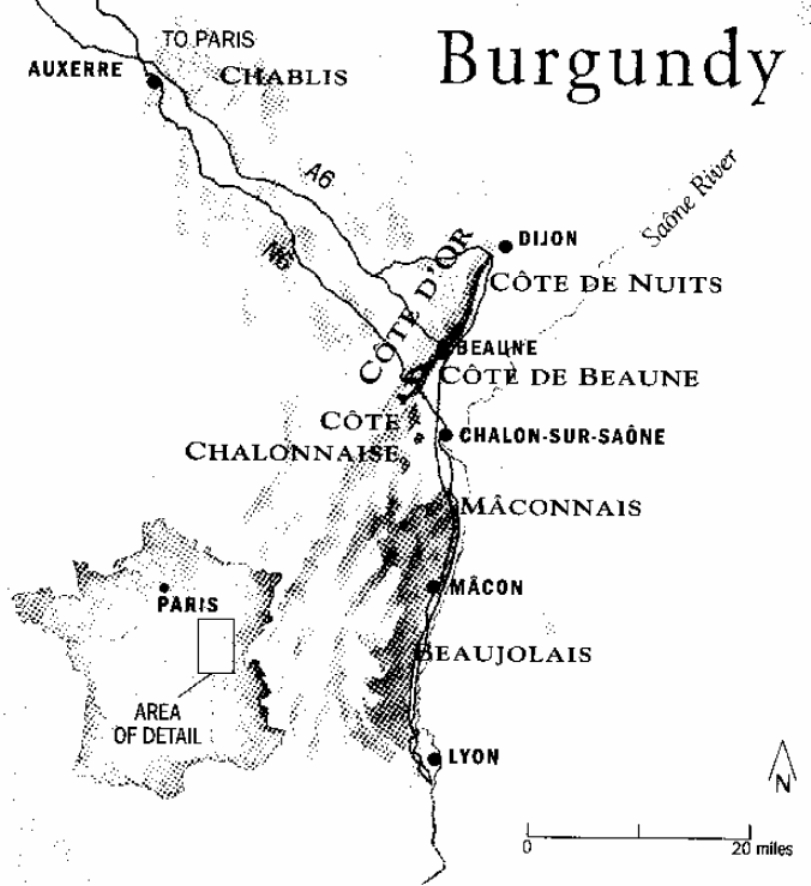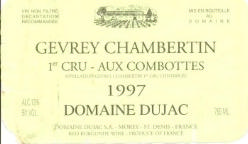Look to Dujac for Burgundy Epiphany
I am no expert on Burgundy, but I know great Burgundy when I find it. Domaine
de la Romanee-Conti, Comte de Vogue, Leroy, Rousseau, and others have their
following, but Dujac really makes my tastes buds stand erect. I have sat in on
several Burgundy tastings over the last year, and every time, it is a Dujac wine that
is the diva. In the puzzling and confusing maize of Burgundy producers, Dujac is
one domaine that you can single out as a consistent star whose wines, although
difficult to come by and not inexpensive, are priced sensibly considering the
quality.
If you really want to know Burgundy, you need to memorize about 4,000 domaine
names, take a course in French pronunciation, and expect to get lost in the maze of
appellations (120) and soil types (59) beneath the Cote d’Or. The Cote stretches
only about 31 miles, but it seems like more because it is so fragmented. After you
get your bearings, you then must prepare yourself to part with a good chunk of
change. Buying Burgundy is like buying designer wine - you pay for the name.
The smaller the appellation, the rarer the wine, the higher the price.

There are actually five main growing regions in Burgundy (from
north to south they are Chablis, Cote d’Or, Cote Chalonaise,
Maconnais, and Beaujolais), but for Pinot Noir enthusiasts, the
Cote d’Or (“coat door”) is the hallowed land. The name Cote
d’Or stands for the “Golden Slope” that extends south from
Dijon to Chagny. The gentle southeast facing slope captures
considerable sunlight from very long summer days. The best
vineyards are half-way up the slope, like meat in the middle of a
sandwich. The lower vineyards have too much clay in the soil
and the upper vineyards are too windy.
The Cote d’Or is divided into the Cote de Nuits in the north and
the Cote de Beaune in the south. The Cote de Nuits has 24
Grand Crus, 138 Premier Crus, and 462 producers. 90% of the
wine is red, 10% white. The Cote de Beaune has 8 Grand Crus,
228 Premier Crus, and 903 producers. 70% of production is
red, 30% white. The historic division is not due to differences in
the character of the wines. For example, Pommard, which is in
the Cote de Beaune, shares a commonality with Chambertin which is in the Cote de Nuits (both are rich, robust, rustic and require aging), and Chambolle-Musigny
in the Cote de Nuits has more in common with Volnay in the Cote de Beaune (both are softer, silkier).
In Burgundy there are two red grapes (Pinot Noir and Gamay) and three white (Chardonnay, Pinot
Blanc, and Pinot Beurot). Gamay may be included in Bourgogne wines from the Cote d’Or and is the
grape of Beaujolais.
In Burgundy, the land, not the producer is classified. Quality is based on geographic possibility, not
the quality in the bottle. In Bordeaux, in contrast, the chateaux names are brand names and the top
names are classified. In Burgundy, the appellations dictate the classification and labeling. The appellations
from lowest to highest: General (Bourgogne rouges and blancs from grapes grown anywhere in
Burgundy; 2/3 of Burgundy production); Regional (ie Cote de Nuits); Regional plus the word villages
(grapes from one or more designated villages, ie Cote de Nuits Villages); Villages (ie Pommard; there
are 8 villages in the Cote de Nuits and 20 in the Cote de Beaune; 20% of Burgundy production);
Premier Cru (label contains name of village and a vineyard with recognized official status; ie Vosne-
Romanee Les Suchots ; there are 426 Premier Cru vineyards in the Cote d’Or; 10% of Burgundy production);
and Grand Cru (a vineyard with recognized official status of the highest quality that need only
use the name of the vineyard since it is assumed you know where the vineyard is; ie La Tache; there
are 32 Grand Cru vineyards in the Cote d’Or; 1% of Burgundy production).

The most expensive agricultural real estate in the world is the 5 mile
stretch from Vosne-Romanee north to Gevrey-Chambertin. This stretch
has more Grand Cru vineyards than any other comparable land in
Burgundy. Vosne-Romanee is considered the greatest Pinot Noir village
on earth. There are 8 Grand Crus (La Romanee, La Tache, Romanee-
Conti, Romanee St.-Vivant, Echezeaux, Grands Echezeaux, and La Grand
Rue). There are 13 Premier Crus (11 are outstanding and 2 - Les Rouges
and En Orveaux are actually in neighboring Flagey-Echezeaux - Les
Suchots, Les Chaumes, Les Brulees, Clos-de-Reas, Aux Malconsorts, Les Petits Monts, Aux Reignots,
Les Beaux-Monts, Cros-Parantoux, Les Gaudichots, En Orveaux, La Croix-Rameau, and Les Rouges).
The vineyards in Burgundy do not have single owners like in California and Oregon. The vineyards in
Burgundy are “climats,” land divided among a number of individual owners. Some owners may have
only a few vines in a row. None of the vines are marked out - owners know which are theirs. There are
very few monopoles (a vineyard owned solely by one owner). The fact that there are several owners
in a single vineyard means you must pay attention to the owner/producer more than the vineyard
name. The vineyard name only indicates potential.
Nothing is for sure in Burgundy. The spellings of vineyard names may take several forms. The
number of Premier Cru vineyards is not certain and several Premier Cru vineyards make better wine
than some Grand Cru vineyards. Because vintages in Burgundy vary wildly due to fluctuations in
climate from year to year, it is important to pay attention to the vintage. But it is equally vital that you
know the producers. Top producers, like Dujac, make quality wines at all appellation levels and in
most vintages.
Learning about Burgundy is a challenge since there are few comprehensive references available. The
two published standard texts are valuable sources of basic information but are outdated: The Great
Domaines of Burgundy by Remington Norman (1998), and Cote D’Or by Clive Coates M.W. (1997). For
more current information, I would recommend Allen Meadows’ website and newsletter,
www.Burghound.com, and the website, www.burgundy-report.com. The best education comes from
tasting the wines of Burgundy.
One comment on prices. The price of Burgundy at auction has shot up 370% in the past decade
according to figures reported in the Wine Spectator. Many wealthy collectors are now favoring
Burgundy over Bordeaux because of its rarity. Obtaining older vintages of Burgundy at auction is
pretty much hopeless for all but the most wealthy wine enthusiasts. Because of the devaluation of the
American dollar in recent years, prices for Burgundy have skyrocketed. We have saved the French in
two World Wars, given them McDonalds, Coke, Mickey Mouse and Jerry Lewis, and what do they do
for us? They charge us ridiculous prices for their wine. The key is to look for village vines and Premier
Crus from good vintages from good producers. There are many good wines to be found in the
$35-$85 price range.

The story of Jacques Seysses and Domaine Dujac is well detailed in Clive
Coates’ excellent book. Jacques Seysses’ wealthy father (he owned Biscuits
Belin) bought Domaine Marcel Graillet in Morey-Saint-Denis for his son in
1967. A new domaine was essentially created from scratch and was of high
promise from the beginning. Immediately Seysses looked to acquire vineyard
land to expand the initial 4.5 ha. The first vintage was in 1968, which he
sold off in bulk. The next vintage, 1969, was one of the finest ever at the
domaine. He married in 1973, and decided to leave the family business permanently for a career in
winemaking. By 1997, the domaine owned 11.5 ha in 11 appellations. Besides village Chambolle-
Musigny and Vosne-Romanee, the Premier Crus include Gevrey-Chambertain Les Combottes, Chambolle-
Musigny Les Gruenchers, Vosne-Romanee Les Beaux Monts, and Grand Crus Clos-de-la Roche,
Clos-Saint-Denis, Charmes Chambertain, Bonnes Mares, and Echezeaux. More recently, Allen
Meadows reports that Seysses, in partnership with a number of investors, has purchased 30+ ha of
vineyard land from Domaine Thomas-Moillard including some Chambertin, Romanee St.-Vivant,
Malconsorts (still uncertain), and more Bonnes Mares and Les Beaux Monts. The first vintage from the
new vineyards will be in 2005. There is also a small negocient operation, Maison Dujac Fils et Père,
which is managed by Jacques’ son, Jeremy. The wines are made from purchased grapes from various
village level appellations and are also of high quality.
What makes Domaine Dujac wines so special? Jacques Seysses was one of the first to recognize the
importance of clones which he prefers over selection massale. Early on, he did considerable replanting
with newer clones. He employs fastidious green harvests. His vineyard manager has been Christophe
Marin since 1987. He vinifies with 100% stems and whole bunches, low-temperature fermentations,
cultured yeasts, and nearly all new Allier French oak. Maybe it is what he doesn’t do that matters.
He says, “I see myself as a doctor. I’m there in case of trouble. But I am not there to change nature.”
At a tasting of 1990 Burgundies last year, with many Grand Crus present, the Dujac Chambolle-
Musigny Les Gruenchers was clearly the finest wine. More recently at a tasting of 15 Burgundies from
1996 to 1999 vintages, the 1997 Dujac Gevry-Chambertain Les Combottes (Premier Cru) and the 1999
Dujac Clos de la Roche (Grand Cru) were the standouts. My notes on Les Combottes say “drinking
beautifully, especially notable lingering finish featuring sandalwood and caramel.” On the Clos de la
Roche I said, “gorgeous nose, makes me want to dive in, big, young, intense but silky smooth, perfect
balance, infanticide.” More recently I attended a tasting organized by Greg Saunders, winemaker at
White Rose Vineyards in Oregon. We tasted blind 3 vintages of DRC Richebourg (2000, 2001, 2002)
and 3 producers of Clos de la Roche from the 2002 vintage (Drouhin, Dujac, Laurent). The tasting was
part of an ongoing project of Greg’s to follow the development of Grand Cru wines over their evolution
through the years. The Dujac Clos de la Roche was an outrageous wine that clearly overshadowed
every other wine in the tasting by my measure (and the opinion of several others). Some of the comments
on the wine were, “voluptuous nose of cherry, spice, cinnamon, rich structure of red and blue
fruits, impeccable balance, taste lingered, iron minerality, plentiful ripe tannins, delicious, perfect.

Domaine Dujac wines are distributed in the United States by
Wilson-Daniels Ltd and Chambers & Chambers (Southern
California). The 1999 and 2002 vintages were unrivaled. For the
2004 vintage, which Jacques Sessyes characterizes as “good but
not great,” Morey-Saint-Denis and Chambolle-Musigny Villages
are priced around $50, the Premier Crus from $110 to $150, and
the Grand Crus $150-225. Do not ignore so-called off years like
1997 and 2000 where the wines are considerably less expensive
but still charming and more approachable now. Finding the
wines can take some research and a good wine retailer can be invaluable. Internet search engines
such as www.winecap.com and www.wine-searcher.com can be very helptful.